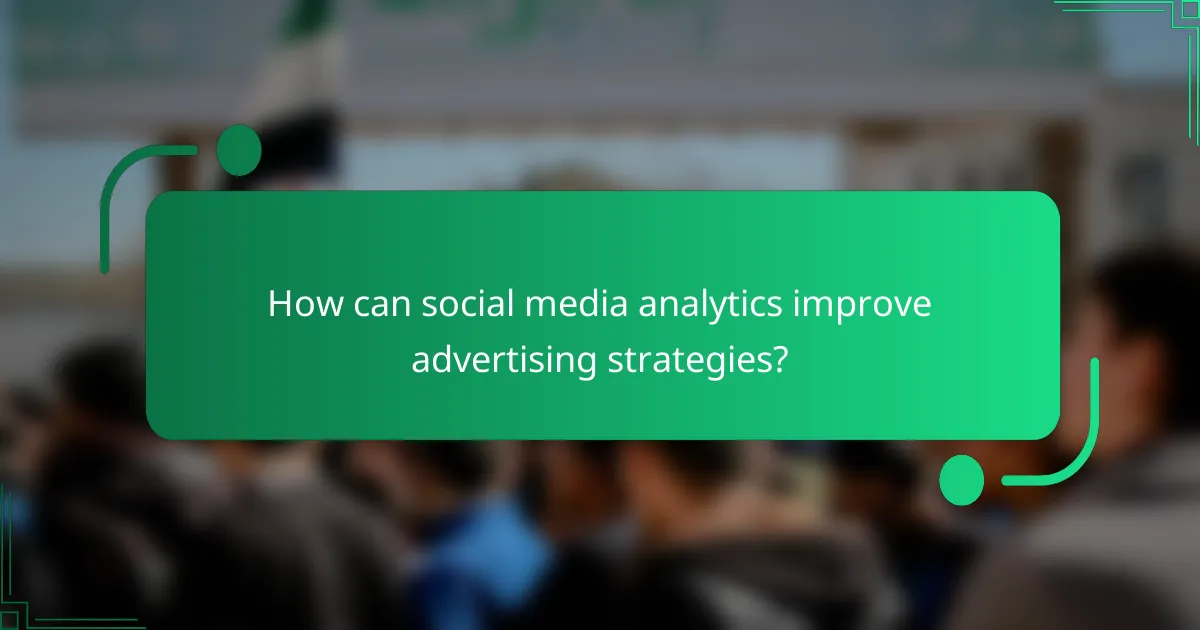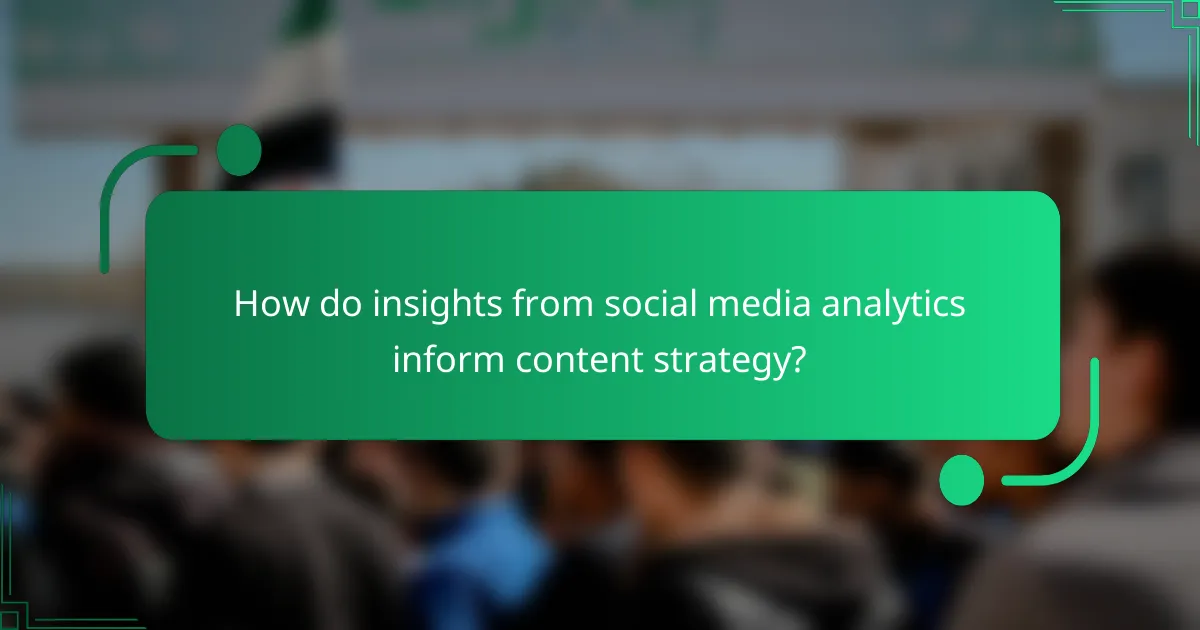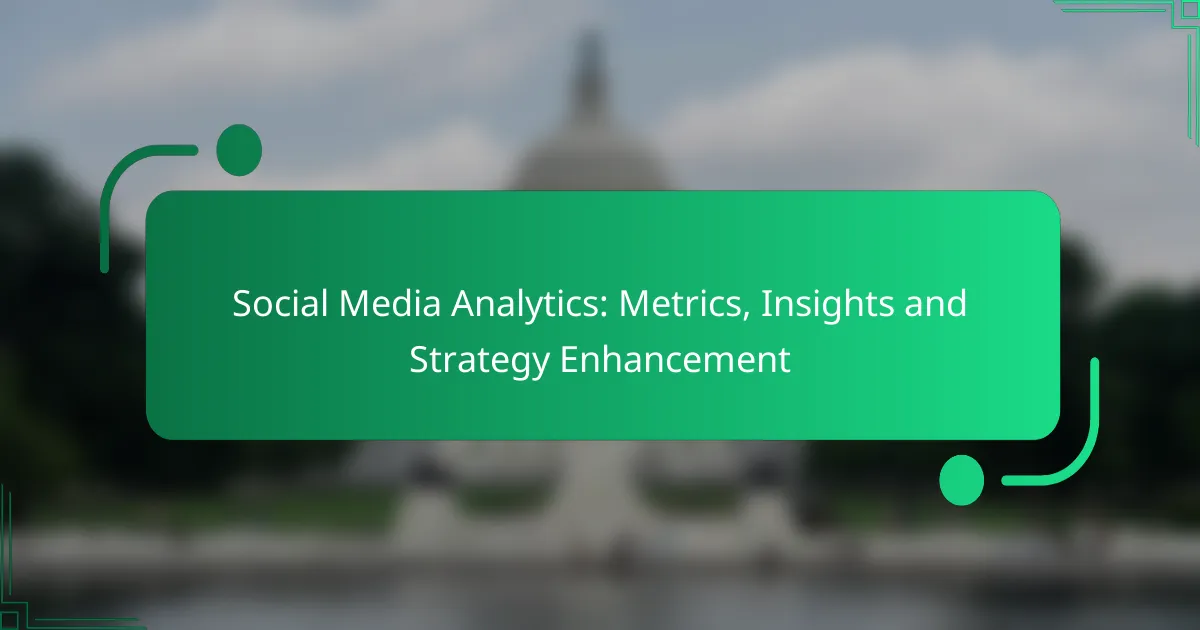Social media analytics is essential for businesses looking to refine their advertising strategies through data-driven insights. By examining key metrics such as engagement rates, reach, and conversion rates, companies can gain a deeper understanding of audience behavior and preferences. This knowledge enables them to optimize content strategies and enhance overall campaign effectiveness, ensuring that their messaging resonates with target audiences.

How can social media analytics improve advertising strategies?
Social media analytics can significantly enhance advertising strategies by providing insights into audience behavior, preferences, and engagement patterns. By leveraging these metrics, businesses can optimize their campaigns for better targeting and effectiveness.
Enhanced targeting
Enhanced targeting allows advertisers to reach specific demographics more effectively. By analyzing data such as age, location, and interests, businesses can tailor their ads to resonate with the right audience. For example, a fitness brand might target ads to users interested in health and wellness, increasing the likelihood of conversions.
Utilizing tools like Facebook Ads Manager or Google Ads can help refine targeting options based on analytics. Regularly reviewing audience insights can also reveal shifts in demographics, allowing for timely adjustments to advertising strategies.
Increased engagement
Increased engagement is a direct result of understanding what content resonates with your audience. By analyzing likes, shares, and comments, businesses can identify which types of posts generate the most interaction. For instance, a company might find that video content performs better than static images, prompting a shift in their content strategy.
To boost engagement, consider experimenting with different formats and posting times based on analytics insights. Engaging with followers through comments and direct messages can also foster a sense of community, further enhancing interaction rates.
Data-driven decision making
Data-driven decision making involves using analytics to guide advertising strategies rather than relying on intuition. By evaluating performance metrics, businesses can determine which campaigns are effective and which need adjustment. For example, if a particular ad set shows low click-through rates, it may be time to revise the creative or targeting approach.
Establishing key performance indicators (KPIs) is crucial for measuring success. Regularly tracking these metrics ensures that strategies remain aligned with business goals. Avoid common pitfalls by not ignoring underperforming ads; instead, use the data to inform future campaigns and improve overall effectiveness.

What key metrics should be tracked in social media analytics?
Key metrics in social media analytics include engagement rate, reach and impressions, and conversion rate. Tracking these metrics helps businesses understand their audience’s behavior, optimize content strategies, and measure the effectiveness of campaigns.
Engagement rate
The engagement rate measures how actively users interact with your content, typically expressed as a percentage of total followers or impressions. It includes likes, shares, comments, and other interactions, providing insight into how compelling your content is.
To calculate engagement rate, divide the total engagements by the total reach or impressions, then multiply by 100. A good engagement rate varies by platform but generally falls between 1% and 5% for most businesses.
To improve engagement, focus on creating high-quality, relevant content that resonates with your audience. Avoid posting too frequently, as this can lead to audience fatigue and lower engagement rates.
Reach and impressions
Reach refers to the total number of unique users who see your content, while impressions count how many times your content is displayed, regardless of whether it was clicked. Both metrics are crucial for understanding the visibility of your posts.
To maximize reach, consider using targeted ads and optimizing posting times based on when your audience is most active. Impressions can be increased by sharing content across multiple channels and encouraging shares from your followers.
Keep in mind that high reach with low engagement may indicate that your content is not resonating with viewers. Regularly analyze both metrics to adjust your strategy accordingly.
Conversion rate
The conversion rate measures the percentage of users who take a desired action after engaging with your content, such as making a purchase or signing up for a newsletter. This metric is vital for assessing the effectiveness of your social media campaigns in driving business goals.
To calculate conversion rate, divide the number of conversions by the total number of visitors from social media, then multiply by 100. A typical conversion rate can range from 1% to 5%, depending on the industry and campaign specifics.
To enhance conversion rates, ensure that your calls to action are clear and compelling. Test different approaches, such as varying your messaging or the placement of links, to see what resonates best with your audience.

How do insights from social media analytics inform content strategy?
Insights from social media analytics play a crucial role in shaping content strategy by revealing what resonates with the audience, when they are most active, and how different types of content perform. By analyzing these metrics, businesses can tailor their content to better meet audience needs and enhance engagement.
Identifying audience preferences
Understanding audience preferences is essential for creating content that engages users. Social media analytics provide data on demographics, interests, and behaviors, allowing brands to identify which topics and formats are most appealing. For example, if analytics show high engagement with video content among a specific age group, brands can prioritize video production for that audience.
Utilizing tools like sentiment analysis can further refine understanding by gauging audience reactions to different posts. This helps in crafting messages that align with audience values and interests, ultimately driving more meaningful interactions.
Optimizing posting times
Optimizing posting times is vital for maximizing reach and engagement on social media. Analytics can reveal when your audience is most active, allowing you to schedule posts for peak times. For instance, if data indicates that your followers are most engaged during weekday afternoons, aim to post during those hours to increase visibility.
Experimenting with different posting schedules and analyzing the resulting engagement can help fine-tune timing strategies. Additionally, consider time zone differences if your audience is global, ensuring that posts reach users at optimal times across various regions.
Content performance analysis
Content performance analysis involves evaluating how well different types of content perform based on engagement metrics such as likes, shares, and comments. By regularly reviewing these metrics, brands can identify which content formats and topics drive the most interaction. For example, if infographics consistently outperform text posts, it may be beneficial to focus on visual content creation.
Tracking performance over time also allows for trend identification, helping to adapt strategies based on what is currently resonating with the audience. Regularly revisiting and adjusting content strategies based on these insights can lead to sustained growth and engagement on social media platforms.

What tools are available for social media analytics?
Various tools are available for social media analytics, each offering unique features to track performance, engagement, and audience insights. Selecting the right tool depends on specific needs, such as budget, platform compatibility, and desired metrics.
Hootsuite
Hootsuite is a popular social media management platform that provides comprehensive analytics features. It allows users to track engagement metrics, follower growth, and post performance across multiple social networks from a single dashboard.
One key advantage of Hootsuite is its ability to schedule posts and analyze their effectiveness over time. Users can generate reports that highlight trends, helping to refine content strategies. Consider starting with a free trial to explore its capabilities before committing to a subscription.
Sprout Social
Sprout Social offers robust analytics tools that focus on engagement and audience insights. It provides detailed reports on social media performance, including metrics like impressions, clicks, and shares, which can help businesses understand their audience better.
A notable feature of Sprout Social is its competitive analysis, allowing users to compare their performance against industry benchmarks. This can be particularly useful for identifying areas for improvement. Be aware that Sprout Social’s pricing may be on the higher end, so evaluate if the investment aligns with your analytics needs.
Google Analytics
Google Analytics can be utilized for social media analytics by tracking traffic and conversions from social platforms to your website. By setting up UTM parameters, you can gain insights into how social media campaigns drive website engagement and user behavior.
This tool is particularly beneficial for businesses looking to measure ROI from social media efforts. While it may not provide in-depth social media metrics like engagement rates, it excels in understanding the overall impact on web traffic. Ensure you regularly review your analytics to adapt your social media strategy effectively.

How can businesses leverage social media analytics for competitive advantage?
Businesses can gain a competitive edge by utilizing social media analytics to understand their performance, audience preferences, and market dynamics. By analyzing metrics and insights, companies can make informed decisions that enhance their marketing strategies and improve customer engagement.
Benchmarking against competitors
Benchmarking allows businesses to compare their social media performance against competitors, identifying strengths and weaknesses. By analyzing key metrics such as engagement rates, follower growth, and content performance, companies can set realistic goals and improve their strategies.
Tools like Sprout Social or Hootsuite can provide comparative analytics, enabling businesses to visualize their standing in the market. Regularly assessing competitor performance can help identify best practices and areas for innovation.
Identifying market trends
Social media analytics can reveal emerging market trends, helping businesses stay ahead of consumer preferences. By monitoring hashtags, keywords, and engagement patterns, companies can spot shifts in audience interests and adapt their strategies accordingly.
For instance, if analytics show a rising interest in sustainability among followers, a brand might consider promoting eco-friendly products. Utilizing sentiment analysis can further refine understanding of public perception and emerging trends.
Tailoring campaigns to audience behavior
Understanding audience behavior through social media analytics enables businesses to create targeted campaigns that resonate with their followers. Analyzing metrics such as post engagement, click-through rates, and demographic data helps in crafting personalized content.
For effective targeting, businesses should segment their audience based on interests and behaviors. A/B testing different content types can also provide insights into what resonates best, allowing for continuous optimization of campaigns.
